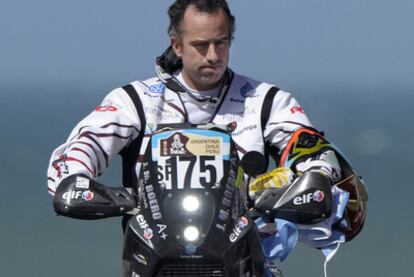Rider dies in opening stage of Dakar
Argentinean biker killed after accident at 55-kilometer mark
The first stage of the Dakar Rally, which took place on Sunday, was marred by tragedy as a 38-year-old Argentinean rider, Jorge Martínez Boero, died after an accident at the 55-kilometer stage of the course.
Boero suffered serious injuries to his chest and was helicoptered to hospital. However, the biker suffered a cardiac arrest once on the aircraft and medics were unable to revive him, despite administering reanimation procedures for five minutes.
The accident will have brought back bad memories for Francisco López Contardo, the Chilean rider better known as "Chaleco." He got the shock of his life in May last year when he rode over a rock in the Saharan desert during the Tunisia Road Rally, a competition that he had won the year before. The accident, which left him unconscious, saw him undergo emergency surgery on his tibia and fibula. He also suffered multiple fractures to his ankle and wrist, as well as sustained a fracture to his neck, a pulmonary edema and a cerebral contusion.
Few would have thought then that the congenial Chilean would have returned to the Dakar Rally in 2012. But, just six months after that horrific accident, he was back on his bike. And on Sunday, he won the first stage of this year's event, which was run through Argentina, taking the competitors from Mar del Plata to Santa Rosa de la Pampa.
The rider finished 14 seconds ahead of Spaniard Marc Coma, who won the Dakar Rally in 2011 and also began the event in fine style on Sunday. Some of his direct competitors did not fare so well, including Coma's teammate, Cyril Despres, who finished 13th, 1m48s off the winning time. Javier Pizzolito, from Argentina, finished third, 27 seconds short.
Away from the motorbikes, the X-raid team, which is running the Mini of Catalan driver Nani Roma, dominated Sunday's car stage. While Roma himself only managed 13th, 2m13s short, his Russian teammate Leonid Novitskiy came first, with Polish driver Krzysztof Holowczyc second, and Stéphane Peterhansel, of France, in third.
It was 2009 when the Dakar Rally swapped the dunes of North Africa for South America, and this year the race will snake through three countries: Argentina, Chile, and, for the first time, Peru.
The race will be made up of 14 grueling stages, which won't leave the drivers with a moment to relax - nor to enjoy the stunning scenery the route will take them through. Of particular note are the stage between San Juan and Chilecito, in Argentina; the border crossing into Chile; and the Andes, which will take the riders to an altitude of 4,700 meters above sea level.
"Every year we try to create a different rally," explains Etienne Lavigne, the director of the rally. "What's more, our spirit has always led us to discover new territories: the attraction this year will be entering in Peru, where we will see four legendary stages."
"This will be the most African Dakar of recent years," said three-time winner Marc Coma before the race began, with reference to the harsh terrain awaiting the riders.
"The last two stages, between Nasca and Pisco, could change the classification," says David Castera, the sporting director of the event. "The dunes are very big and the sand is difficult. Two days from the end we won't have a winner - an advantage of 20 minutes in those dunes is nothing. We'll keep up the suspense right until the end."
The fact that the mighty Volkswagen team is not taking part this year, nor veteran Spanish rally champion Carlos Sainz, means that the field is going to be closer than it has been in recent times. X-raid is likely to be the dominant team in terms of cars, while Marc Coma and Cyril Despres, from KTM, should dominate the motorbikes.
The favorites on the quad bikes look to be the Argentinean brothers Alejandro and Marcos Patronelli, who won the two previous editions.








































